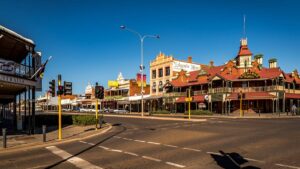Monsters of Rock: Albemarle hammers Canberra’s electric dreams

This 'downstream processing' movie is getting pretty scary. Pic: Getty Images
- Albemarle has halted construction plans at a further two lithium hydroxide trains in WA’s South West
- Coming after a ~85% slide in lithium prices, it puts a dent in Australia’s hopes of becoming an electric vehicle supply chain manufacturing hub
- Materials stocks largely higher as rates, geopolitics pour kerosene on commodities
Do androids dream of electric cars? And by androids we mean whatever AI derived class of politician we have wafting through the halls of Parliament House right now.
While they may do a lot of dreaming, few plans have helped make developing EV and battery supply chain elements beyond our massive spodumene resources more palatable here.
The latest stake through the heart comes from America’s Albemarle, whose investors are pleased to see it’s trimming the fat, sending its shares 1.25% higher in New York after announcing a pause on a string of investments in its Kemerton lithium hydroxide plant in WA.
The basics: Albemarle, the world’s biggest lithium producer and a major converter of lithium units in China, will stop construction on the third train of the plant, put a second train in care and maintenance and focus manufacturing efforts on ramping up and qualifying material from its first train.
It follows a decision to pause construction plans on a fourth 25,000tpa train in the face of tumbling lithium prices. One only wonders how bad the financial stress would be if ALB hadn’t been blocked in its $6.6bn pursuit of Liontown Resources (ASX:LTR) by Gina Rinehart last year.
“The long-term growth potential for our end markets remains strong, and we plan to leverage our core capabilities while ensuring we remain competitive,” said Albemarle head honcho J. Kent Masters said.
“Given the dynamics of the global markets we serve, we must be able to pivot and pace as necessary to maintain our leading position.”
Fallout
The Albemarle announcement comes after continuing losses at the Kwinana lithium hydroxide plant were revealed by 49% owner IGO in its quarterly update this week. High costs, technical issues and long qualifying times with customers have kept Aussie market entrants from breaching the China dominated end of the value chain.
It also follows the proposed closure of BHP’s Nickel West division, including its Kalgoorlie smelter and Kwinana nickel sulphate, powder and briquette refinery until at least 2027.
Both decisions, along with a retraction of Fortescue’s (ASX:FMG) ambitious 2030 green hydrogen production target, have left a gloomy cloud over the Albanese Government’s multi-billion dollar Future Made in Australia program, announcing only in the May Budget.
Federal Resources Minister Madeleine King, whose electorate takes in the Kwinana industrial precinct, said on ABC radio she understood around 300 full time employees would be effected.
FMG cut 700 roles while BHP Nickel West employs 3300, though BHP thinks most non-contractor employees can be placed elsewhere in its short-staffed WA Iron Ore or Copper South Australia businesses.
Hundreds to thousands have lost jobs elsewhere with the closure of a number of other WA nickel mines in response to falling prices while explorers have also had to tighten the belt with capital harder to find.
Incentives originally intended to come into force only in 2027 could be brought forward, King said on the wireless, with billions set aside for tax incentives not ready to be placed until then but commodity prices slamming miners in the present day.
This line is a funny one:
“Well, Albemarle’s one of the biggest lithium producers in the world, so I think their forecasts – well clearly they were not right a year ago when they made a huge investment decision – but they’re probably quite accurate now,” King said.
“Reality has sunk in after a year, and we have to be really honest about the international market. There’s a drop of about 80 to 85 per cent in pricing in lithium over a rapid twelve month period, and it is sticking at that low ten dollars a kilo mark.”
While the decisions are ‘distant’, King said ‘international market forces are at play’.
There’s already been some collateral damage on the bourse today.
Engineering services provider Monadelphous Group (ASX:MND) was crunched after saying Albemarle had terminated contracts worth around $200m going forward.
Separately, ALB reported a US$188m loss for the second quarter but maintained full year market outlook expectations for average weighted prices of US$15/kg for lithium chemicals despite assuming lower July market pricing could persist for the rest of the year (Fastmarkets: US$11,900/t today). It already Average weighted prices came in at US$20/kg in its fourth quarter of 2023 and US$25/kg in the second half of 2023.
A US$900m-1.1bn impairment charge will be on top of a US$215m post-tax charge levelled in the second quarter to account for the halting of Stage 4 plant construction.
Adjusted EBITDA was down 69.5% YoY from US$1.26bn to US$386.4m in the June quarter, with adjusted diluted earnings per share sinking 99.5% from US$7.33 to US$0.04.
Market moves
Didn’t seem to have much impact in the market, aside from poor Monos (normally not something you say about the mono itself), with ASX lithium players both up and down today.
Pilbara Minerals (ASX:PLS) lifted almost 3% in morning trade after forking out $20m for gold tenements held by junior Kairos Minerals (ASX:KAI) neighbouring its world-class Pilgangoora lithium mine.
It is, of course, interested in the lithium and tantalum rights there but also gets a small 230,000oz gold resources, with Kairos to get gold and base metal rights over an additional 367km2 in the Pilbara with known gold occurrences and maintain control of its 1.38Moz main trend resource at Mt York.
The broader commodity market was buoyant, with materials 0.92% higher and energy up 1.12%
Base metals soared on hopes of a September rate cut from the US Fed and the threat of growing war in the Middle East spiking gold and oil after Israel assassinated Hamas political leader Ismail Haniyeh in Tehran.
Making gains
Pilbara Minerals (ASX:PLS) (lithium) +4.4%
Sandfire Resources (ASX:SFR) (copper) +4.5%
Silex Systems (ASX:SLX) (uranium) +3%
Mount Gibson Iron (ASX:MGX) (iron ore) +2.8%
Eating losses
Monadelphous Group (ASX:MND) (mining services) -4.9%
Red 5 (ASX:RED) (gold) -5.1%
Nickel Industries (ASX:NIC) (nickel) -2.9%

UNLOCK INSIGHTS
Discover the untold stories of emerging ASX stocks.
Daily news and expert analysis, it's free to subscribe.
By proceeding, you confirm you understand that we handle personal information in accordance with our Privacy Policy.








